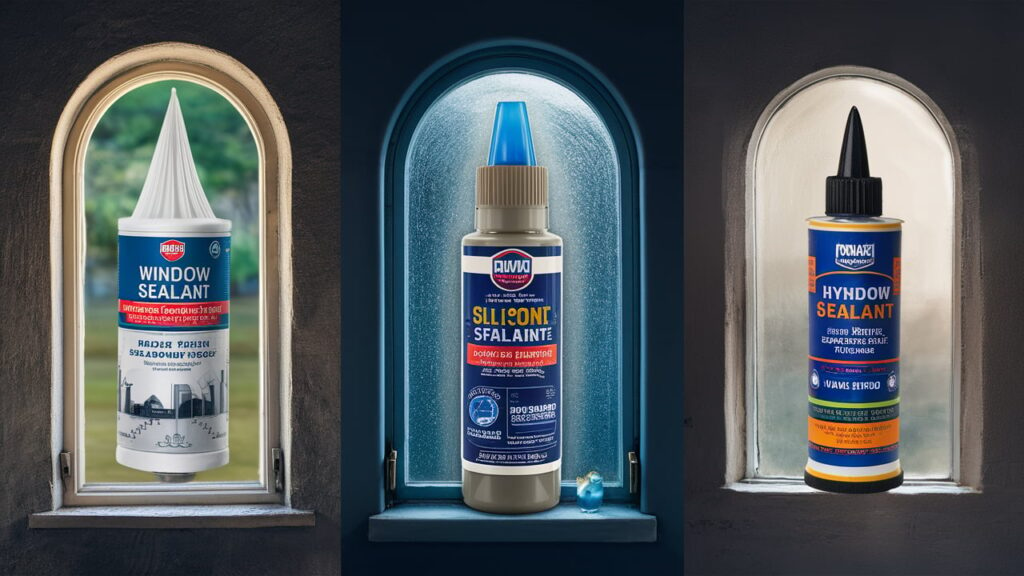Choosing the right waterproof sealant for house windows is crucial. It ensures windows stay leak-free and durable.
Homeowners often face the dilemma of picking the best window sealant. There are many options, each promising durability and waterproofing. But not all sealants are equal. Some work better in certain climates, while others excel in ease of application. Understanding the differences helps in making the right choice.
This guide will explore top waterproof sealants, helping you find the perfect fit for your windows. Let’s dive into what makes a sealant effective and which ones stand out.
Importance Of Window Sealants
Windows are an essential part of every house. They offer natural light, fresh air, and a view of the outside. Yet, without proper sealing, windows can cause problems. Water leaks, drafts, and higher energy bills are common issues. This is where window sealants come in. They help keep your home protected and efficient.
Preventing Leaks
Water leaks can damage your home. Mold can grow, wood can rot, and walls can stain. A good window sealant can stop water from seeping in. It forms a barrier between the window and the frame. This barrier keeps water out. Waterproof sealants are best for this job. They can withstand rain, snow, and humidity.
Choosing the right sealant is crucial. Some common types include silicone, polyurethane, and latex. Silicone is flexible and lasts long. Polyurethane is tough and durable. Latex is easy to use and clean. Each type has its own benefits. Consider your needs before choosing.
Enhancing Insulation
Good insulation keeps your home warm in winter and cool in summer. Windows are often the weak point in home insulation. Sealants can help. They fill gaps and cracks around windows. This stops air from leaking in or out. Better insulation means lower energy bills.
Different sealants offer different levels of insulation. Silicone and polyurethane are good choices. They form a tight seal that doesn’t break down easily. This keeps your home comfortable year-round.
| Type of Sealant | Best For | Benefits |
|---|---|---|
| Silicone | Flexibility | Long-lasting, waterproof |
| Polyurethane | Durability | Tough, strong |
| Latex | Ease of use | Easy to apply, clean |
Types Of Window Sealants
Choosing the right window sealant can make a big difference in your home’s comfort. Sealants help keep water and drafts out, ensuring your windows remain secure. There are several types of window sealants available, each with its own advantages. Let’s explore the different types of window sealants to help you decide which is best for your house windows.
Silicone Sealants
Silicone sealants are popular for their durability and flexibility. They withstand extreme temperatures and weather conditions. Silicone sealants adhere well to glass, metal, and plastic surfaces. They provide long-lasting waterproofing, making them ideal for exterior windows. One downside is that silicone sealants can be difficult to paint over.
Polyurethane Sealants
Polyurethane sealants are known for their strong adhesion and toughness. They can bond to various materials like wood, metal, and masonry. These sealants are resistant to abrasion and tearing. Polyurethane sealants provide excellent waterproofing and can be painted to match your window frames. They are suitable for both interior and exterior use.
Acrylic Sealants
Acrylic sealants are easy to apply and clean up with water. They are less flexible than silicone and polyurethane sealants. Acrylic sealants are best for interior applications where movement is minimal. They are paintable, making them a good choice for areas requiring a seamless finish. These sealants are generally less expensive but may not last as long as silicone or polyurethane options.
Factors To Consider
Choosing the right window sealant for your house windows can be challenging. Different factors affect the performance and longevity of the sealant. Understanding these factors will help you make the best choice for your needs.
Durability
The durability of a window sealant is crucial. It needs to withstand various weather conditions. A durable sealant will last longer and provide better protection. Consider sealants that resist UV rays, moisture, and temperature fluctuations. This ensures that your windows remain sealed for years.
Flexibility
Flexibility is another key factor. As temperatures change, windows expand and contract. A flexible sealant can adapt to these movements. This prevents cracks and gaps from forming. Choose a sealant that maintains its flexibility in different conditions. This will keep your windows sealed and energy-efficient.
Ease Of Application
Applying the sealant should be straightforward. Some sealants are easier to apply than others. Look for products with user-friendly instructions. A sealant that comes with an applicator is a plus. This ensures a smooth and even application. An easy-to-apply sealant saves time and reduces stress.

Recommended Acrylic Sealants
Choosing the right acrylic sealant for your house windows can be daunting. Acrylic sealants are well-known for their flexibility and durability. They are perfect for sealing gaps and cracks around windows. Here, we discuss two highly recommended acrylic sealants for house windows.
Product E
Product E is a top-rated acrylic sealant. It offers excellent adhesion to various surfaces. This product is easy to apply and dries quickly. It remains flexible even in extreme weather conditions. Product E is also paintable, allowing you to match it with your window frames. It has a long lifespan, ensuring your windows stay sealed for years.
Product F
Product F is another excellent choice for sealing house windows. It provides a strong, watertight seal. This sealant is resistant to UV rays and weathering. It is easy to clean up with water before it cures. Product F adheres well to wood, metal, and vinyl surfaces. It also maintains its flexibility, preventing cracks over time.
Application Tips
Applying the right window sealant can make a significant difference in keeping your home dry and energy-efficient. To help you get the best results, follow these tips for a smooth and effective application.
Preparation Steps
Proper preparation is key to a successful application. Follow these steps:
- Clean the Surface: Remove dirt, dust, and old sealant. A clean surface ensures better adhesion.
- Dry the Area: Ensure the window frame is completely dry. Moisture can affect the sealant’s ability to bond.
- Masking Tape: Use tape to protect adjacent areas. This provides a neat finish and prevents unwanted smears.
Applying Evenly
An even application ensures a strong and durable seal. Here’s how:
- Choose the Right Tool: Use a caulking gun for better control. This helps in applying the sealant evenly.
- Apply in Sections: Work in small sections to maintain consistency. This avoids gaps and overlaps.
- Smooth the Sealant: Use a tool or your finger to smooth the sealant. This ensures it fills all gaps and adheres well.
Curing Time
Allowing the sealant to cure properly is crucial for its effectiveness. Keep these points in mind:
| Type of Sealant | Recommended Curing Time |
|---|---|
| Silicone Sealant | 24-48 hours |
| Polyurethane Sealant | 5-7 days |
| Acrylic Latex Sealant | 24-48 hours |
Avoid touching or disturbing the sealant during curing. This ensures it sets properly and provides a waterproof seal.
Maintenance Advice
Choosing the best window sealant for waterproofing is just the first step. Proper maintenance ensures long-lasting protection. This section provides maintenance advice for your window sealants, ensuring your home remains secure from water damage.
Regular Inspections
Inspect your window sealants every six months. Look for any cracks or gaps. These can let water seep in, causing damage. Use a flashlight to see better. Check the corners and edges closely. Water stains on walls or window sills can be signs of leakage.
Reapplication Guidelines
Over time, sealants can wear out. Follow these steps for reapplication:
- Clean the surface: Remove old sealant and dirt.
- Choose the right sealant: Use the same type as the original.
- Apply evenly: Use a caulking gun for best results.
- Let it dry: Follow the manufacturer’s drying time.
Common Issues And Solutions
Sealants can face common issues. Here are some solutions:
| Issue | Solution |
|---|---|
| Cracking | Reapply sealant. Use a more flexible type. |
| Discoloration | Clean with mild soap. Replace if needed. |
| Peeling | Remove old sealant. Clean and reapply. |
Frequently Asked Questions
What Is The Best Waterproof Sealant For Windows?
The best waterproof sealant for windows is usually silicone-based. It provides excellent adhesion and flexibility. Silicone sealants are durable and resistant to weather conditions. They are ideal for preventing water leaks around house windows.
How Long Does Window Sealant Last?
Window sealant typically lasts around 10 to 20 years. However, the lifespan depends on the quality of the sealant. Proper application and weather conditions also play crucial roles in longevity.
Can I Apply Window Sealant Myself?
Yes, applying window sealant yourself is possible. Ensure you clean the area thoroughly before application. Follow the manufacturer’s instructions for best results. For complex issues, consider hiring a professional.
Does Window Sealant Prevent Drafts?
Yes, window sealant can effectively prevent drafts. It seals gaps and cracks around windows. This keeps your home energy-efficient and comfortable. Regular inspection and maintenance are essential.
Conclusion
Choosing the right window sealant is crucial for waterproofing your house. It ensures protection against leaks and weather damage. Silicone sealants offer flexibility and durability. Polyurethane types provide strong adhesion and longevity. Consider your specific needs and climate conditions. Always follow the manufacturer’s instructions for the best results.
Proper application guarantees a long-lasting seal. Invest time in selecting the best sealant. Your windows will stay secure and dry, enhancing your home’s comfort and value.








